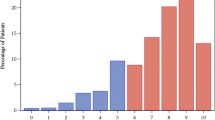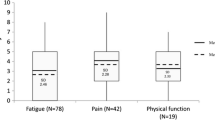Abstract
Purpose
The purpose of this study was to examine the psychometric properties of a single-item visual analog scale (VAS) to measure goals of care in patients with advanced cancer.
Methods
Data were obtained from 378 patients with diagnoses of advanced lung, gastrointestinal, or pancreatic cancer. Goal of care was measured at baseline and every 3 months until patient death or completion of the 15-month study period. A single-item VAS ranging from 0 (quality of life is all that matters) to 100 (length of life is all that matters) was used to measure patients’ goals of care for all study subjects; a subsample of subjects also completed the Quality of Life-Length of Life scale which asked patients to select categories of preferences. Test–retest reliability (intra-class correlation) and construct validity (known-groups, convergent, divergent) were evaluated.
Results
At 9 and 12 months, the test–retest reliability for patients with stable symptoms (n = 107) was established with the ICC(1,3) = 0.81, p < .001. Known-groups (r = 0.99, p < .001), convergent (r = 0.78, p < .001), and divergent (r = .06, p = 0.24) validity all demonstrated evidence of good construct validity.
Conclusions
Preliminary psychometric testing for a single-item VAS that measures goals of care in a sample of patients with advanced cancer met standard requirements for reliability and validity. While further testing with a larger sample size is recommended, the tool’s use in the clinical area to assess cancer patients’ goals of care is appropriate. Such a tool could facilitate goals of care discussions in the clinical area.

Similar content being viewed by others
References
Bischoff, K., O’Riordan, D. L., Marks, A. K., Sudore, R., & Pantilat, S. Z. (2018). Care planning for inpatients referred for palliative care consultation. Journal of the American Medical Association,178(1), 48–54.
Kaplan, S. H., Greenfield, S., & Ware, J. E. (1989). Assessing the effects of physician-patient interactions on the outcomes of chronic disease. Medical Care,27(3 Suppl), S110–S127.
Roter, D. L., Hall, J. A., Kern, D. E., Barker, L. R., Cole, K. A., & Roca, R. P. (1995). Improving physicians’ interviewing skills and reducing patients’ emotional distress. A randomize clinical trial. Archives of Internal Medicine,155(17), 1877–1884.
Bertakis, K. D., Roter, D., & Putnam, S. M. (1991). The relationship of physician medical interview style to patient satisfaction. Journal of Family Practice,32(2), 175–181.
Wright, A. A., Zhang, B., Ray, A., Mack, J. W., Trice, E., Balboni, T., et al. (2008). Associations between end-of-life discussions, patient mental health, medical care near death, and caregiver bereavement adjustment. Journal of the American Medical Association,300(14), 1665–1673.
You, J. J., Fowler, R. A., Heyland, D. K., & Canadian Researchers at the End of Life Network (CARENET). (2014). Just ask: discussing goals of care with patients in hospital with serious illness. Canadian Medical Association Journal,186(6), 425–432.
Balogh, E. P., Ganz, P. A., Murphy, S. B., Nass, S. J., Ferrell, B. R., & Stovall, E. (2011). Patient-centered cancer treatment planning: Improving the quality of oncology care. Summary of an Institute of Medicine workshop. The Oncologist,16(12), 1800–1805.
Douglas, S. L., Lipson, A. R., & Daly, B. J. (2018). Analyzing goals of care in advanced cancer patients and their family caregivers: Evidence-based research. POJ Nursing Practice and Research,2(1), 1–4.
Derry, H. M., Reid, M. C., & Prigerson, H. G. (2019). Advanced cancer patients' understanding of prognostic information: Applying insights from psychological research. Cancer Medicine,8(9), 4081–4088.
LeBlanc, T.W., Tulsky, J. (2018). Discussing goals of care. Block, S.D., ed. Resource document. UpToDate Inc. Retrieved September 9, 2019, from https://www.uptodate.com/contents/discussing-goals-of-care?search=Discussing%20goals%20of%20care&source=search_result&selectedTitle=1~150&usage_type=default&display_rank=1.
Meropol, N. J., Weinfurt, K. P., Burnett, C. B., Balshem, A., Benson, A. B., Castel, L., et al. (2003). Perceptions of patients and physicians regarding phase I cancer clinical trials: implications for physician-patient communication. Journal of Clinical Oncology,21(13), 2589–2596.
Sanders, J. J., Curtis, J. R., & Tulsky, J. A. (2018). Achieving goal-concordant care: A conceptual model and approach to measuring serious illness communication and its impact. Journal of Palliative Medicine,21(S2), S17–S27.
Bijur, P. E., Silver, W., & Gallagher, J. (2001). Reliability of the visual analog scale for measurement of acute pain. Academic Emergency Medicine,8(12), 1153–1157.
Back, A. L. (2017). What enables oncologists to discuss goals of care with their patients? practical ways toward a culture of kindness, transparency, and responsibility. Journal of Oncology Practice,13(9), 591–593.
Rhee, H., Belyea, M., & Mammen, J. (2017). Visual analogue scale (VAS) as a monitoring tool for daily changes in asthma symptoms in adolescents: A prospective study. Allergy, Asthma & Clinical Immunology,13, 24–31.
Haley, K. L., Womack, J. L., Harmon, T. G., & Williams, S. W. (2015). Visual analog rating of mood by people with aphasia. Topics in Stroke Rehabilitation,22(4), 239–245.
Heller, G. Z., Manuguerra, M., & Chow, R. (2016). How to analyze the visual analogue scale: myths, truths and clinical relevance. Scandinavian Journal of Pain,13, 67–75.
de Boer, A. G., van Lanschot, J. J., Stalmeier, P. F., van Sandick, J. W., Hulscher, J. B., de Haes, J. C., et al. (2004). Is a single-item visual analogue scale as valid, reliable and responsive as multi-item scales in measuring quality of life? Quality of Life Research,13(2), 311–320.
Stanek, S. (2017). Goals of care: a concept clarification. Journal of Advanced Nursing,73(6), 1302–1314.
Meropol, N. J., Egleston, B. L., Buzaglo, J. S., Benson, B., Cegala, D. J., Diefenbach, M. A., et al. (2008). Cancer patient preferences for quality and length of life. Cancer,113(12), 3459–3466.
Weinfurt, K. P., Castel, L. D., Li, Y., Sulmasy, D. P., Balshem, A. M., Benson, A. B., et al. (2003). The correlation between patient characteristics and expectations of benefit from phase I clinical trials. Cancer,98(1), 166–175.
Winter, L., & Parks, S. M. (2008). Family discord and proxy decision makers' end-of-life treatment decisions. Journal of Palliative Medicine,11(8), 1109–1114.
Winter, L. (2013). Patient values and preferences for end of life treatments: Are values better predictors than a living will? Journal of Palliative Medicine,16(4), 362–368.
Hui, D., & Bruera, E. (2017). The edmonton symptom assessment system 25 years later: Past, present and future developments. Journal of Pain and Symptom Management,53(3), 630–643.
Carvaja, A., Centeno, C., Watson, R., & Bruera, E. (2011). A comprehensive study of psychometric properties of the Edmonton Symptom Assessment System (ESAS) in Spanish advanced cancer patients. European Journal of Cancer,47(12), 1863–1872.
Polit, D. F., & Beck, C. T. (2017). Nursing research: Generating and assessing evidence for nursing practice (10th ed.). Philadelphia: Wolters Kluwer Health.
Amit, M., Hutcheson, K., Zaveri, J., Lewin, J., Kupferman, M. E., Hessel, A. C., et al. (2019). Patient-reported outcomes of symptom burden in patients receiving surgical or nonsurgical treatment for low-intermediate risk oropharyngeal squamous cell carcinoma: a comparative analysis of a prospective registry. Oral Oncology,91, 13–20.
Waltz, C. F., Strickland, O. L., & Lenz, E. R. (2005). Measurement in nursing and health research (3rd ed.). New York: Springer.
DeVon, H. A., Block, M. E., Moyle-Wright, P., Ernst, D. M., Hayden, S. J., Lazzara, D. J., et al. (2007). A psychometric toolbox for testing validity and reliability. Journal of Nursing Scholarship,39(2), 155–164.
Mokkink, L. B., Terwee, C. B., Knol, D. L., Stratford, P. W., Alonso, J., Patrick, D. L., et al. (2010). The COSMIN checklist for evaluating the methodological quality of studies on measurement properties: A clarification of its content. BioMedCentral Medical Research Methodology,10, 22.
Campbell, D. T., & Fiske, D. W. (1959). Convergent and discriminant validation by the multitrait-multimethod matrix. Psychological Bulletin,56(2), 81–105.
Cohen, J. (1977). Statistical power analysis for the behavioral sciences (Rev. ed.). Hillsdale: Lawrence Erlbaum Associates, Inc.
Perron, B., & Gillespie, D. (2015). Key concepts in measurement. New York, NY: Oxford University Press.
Sendlbeck, M., Araujo, E. G., Schett, G., & Englbrecht, M. (2015). Psychometric properties of three single-item pain scales in patients with rheumatoid arthritis seen during routine clinical care: A comparative perspective on construct validity, reproducibility and internal responsiveness. Rheumatic and Musculoskeletal Diseases Open,1, 1–9.
Yen, M., & Lo, L. H. (2002). Examining test-retest reliability: An intra-class correlation approach. Nursing Research,51(1), 59–62.
Gang, C., Taylor, P. A., Haller, S., Kircanski, K., Stoddard, J., Pine, D. S., et al. (2018). Intraclass correlation: Improved modeling approaches and applications for neuroimaging. Human Brain Mapping,39(3), 1187–1206.
Sandberg, A., Cider, Å., Jivegård, L., Nordanstig, J., Wittboldt, S., & Bäck, M. (2020). Test-retest reliability, agreement, and minimal detectable change in the 6-minute walk test in patients with intermittent claudication. Journal of Vascular Surgery,71(1), 197–203.
Koo, T. K., & Li, M. Y. (2016). Cracking the code: providing insight into the fundamentals of research and evidence-based practice—A guideline of selecting and reporting intraclass correlation coefficients for reliability research. Journal of Chiropractic Medicine,15(2), 155–163.
Trochim, W. M. K. (2005). The research methods knowledge base (2nd ed.). Cincinnati, OH: Atomic Dog Publishing.
Paiva, C. E., Barroso, E. M., Carneseca, E. C., Souza, C. P., dos Santos, F. T., Mendoza Lopez, R. V., et al. (2014). A critical analysis of test-retest reliability in instrument validation studies of cancer patients under palliative care: a systematic review. BioMedCentral Medical Research Methodology,14, 8–18.
Acknowledgements
Supported by Grant No. NRO14856, National Institute of Health/National Institute of Nursing Research
Author information
Authors and Affiliations
Corresponding author
Ethics declarations
Conflict of interest
The authors declare that they have no conflict of interest.
Additional information
Publisher's Note
Springer Nature remains neutral with regard to jurisdictional claims in published maps and institutional affiliations.
Rights and permissions
About this article
Cite this article
Douglas, S.L., Pignatello, G., Park, S. et al. Psychometric properties of a single-item visual analog scale measuring goals of care in patients with advanced cancer. Qual Life Res 29, 1999–2005 (2020). https://doi.org/10.1007/s11136-020-02458-w
Accepted:
Published:
Issue Date:
DOI: https://doi.org/10.1007/s11136-020-02458-w




